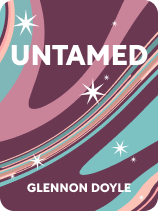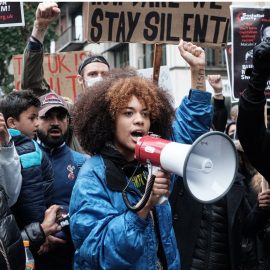

This article is an excerpt from the Shortform book guide to "Untamed" by Glennon Doyle. Shortform has the world's best summaries and analyses of books you should be reading.
Like this article? Sign up for a free trial here .
Are women conditioned to suppress their true identities? How does society feed into this problem? How can we make a change?
Glennon Doyle’s Untamed shows how the author freed herself from the captivity of society’s expectations. The Untamed book offers insight on the issues of parenting, spirituality, empowering women, rejecting patriarchy and oppression, feminism, and sexuality.
Read our overview of Glennon Doyle’s Untamed to find out Doyle’s advice for changing your life and living according to your own rules.
Glennon Doyle’s Untamed
In the Untamed book, speaker, author, and activist Glennon Doyle explores how she freed herself from the strictures of society and embraced her true identity by rejecting the expectations and limitations society imposes on women. Her book is an intimate memoir—telling her personal story of addiction and rehab, falling in love with a woman, leaving her marriage, and rebuilding her family—and a call to action. Glennon Doyle’s Untamed book asks readers to use Glennon Doyle’s story as a framework to examine their lives and deconstruct societal expectations, thereby liberating themselves from the metaphorical captivity that limits their potential.
Untamed: The Book’s Context
Glennon Doyle’s Untamed came out in early 2020 and achieved extreme popularity during the early months of the Covid-19 pandemic. For many, quarantine felt like a type of cage in which they felt trapped, physically and mentally. Glennon Doyle’s message of captivity and freedom resonated with many readers, especially women, who felt trapped in traditional gender roles as they were forced to take on more household duties and childcare during the pandemic.
Glennon Doyle’s Untamed, like many memoirs, offers snapshots of events from Doyle’s life organized around a main theme, with the aim of sharing her experiences and communicating essential realizations about how to live as a woman. This combination of personal experience and self-help inspiration is present in many books of the genre, such as Elizabeth Gilbert’s memoir Eat, Pray, Love. Gilbert is good friends with Doyle; they have inspired each other’s work.
Although the book Untamed shares many similarities with more traditional memoirs such as Eat, Pray, Love, Glennon Doyle’s Untamed mentions in an interview that she wanted Untamed to “feel wild” and not be similar to any other memoir or self-help book. She said she wrote the book in a burst of creative inspiration and wants the reader to feel swept away by its propulsive energy. As a result, Untamed exists in its own category as a combination of memoir, self-help, and expressive artistic statement.
Untamed: The Book’s Pathways to Freedom
Doyle identified the “pathways” that had allowed her to escape captivity. To regain their freedom, she says, women must rediscover the wildness within them.
Doyle argues that you must embrace the qualities taken away or diminished during captivity to live in your primal state. By understanding what was taken away during captivity, you can recognize and unlearn your social conditioning. Doyle introduces four pathways to help you identify and recover these lost capacities and instincts.
- Pathway #1: Embracing Your Emotion—numbing your emotions has stopped you from being able to express your feelings. This pathway encourages you to embrace and express your emotions to be fully human.
- Pathway #2: Embracing Your Intuition—the tendency to look to others for validation has diminished your ability to tap into your intuition and trust your decisions. By following this pathway, you can learn to explore your intuition through quiet reflection.
- Pathway #3: Embracing Your Imagination—the social message that you must accept—and be nothing but grateful for— your current reality has diminished your ability to imagine a new reality. Embracing your imagination will help you create a better, more vibrant life.
- Pathway #4: Embracing Deconstruction and Reconstruction—your ability to deconstruct your existing beliefs and rebuild a new life for yourself has been taken away by society’s interest in maintaining the status quo. This pathway helps you deconstruct your old ways of thinking so you can rebuild your life around emotion, inner knowledge, and imagination.
Glennon Doyle’s Untamed: Key Advice
Doyle’s experiences have taught her a great deal about how to rebuild life on her terms, and she calls her readers to do the same. She asserts that the world needs more wild women, and suggests four ways you can begin rebuilding your life to align with your truest self.
1) Let go of your old assumptions, beliefs, worldviews, and social conditioning. Be committed to holding on to nothing but the truth. Start a journal to reflect on how your ideas about gender, sexuality, family life, religion, and race have been influenced by society’s messaging.
(Shortform note: Committing to letting go of old beliefs and writing about your social conditioning can be overwhelming if you try to tackle too many beliefs at once—focus on just a few of these beliefs at a time. In Awaken the Giant Within, Tony Robbins provides a useful process for addressing just a few damaging beliefs at a time. He suggests writing down all of your beliefs and then identifying the ones that have had significant negative impacts on your life. Robbins says that you then choose just two of these negative beliefs—and focus on thoroughly deconstructing each one. You can revisit this lexercise as needed until you deconstruct each negative belief on the list.)
2) Be willing to lose the things in your life that are good enough. When you create a more beautiful vision of your life, you should never compromise that vision by tolerating the things that are just “good enough.”
(Shortform note: There’s some debate around the value of “good enough” things. While Doyle encourages you to reject “good enough,” other authors argue that you should embrace it. In Good Enough, Kate Bowler suggests that the expectation that your life should be in a state of constant pursuit of “the best” is an unrealistic goal—and this commitment to only the best can make it harder for you to handle setbacks or disappointment. Bowler says that you should instead embrace the “good enough” life. This means striving for what is possible today, while acknowledging that there may be setbacks in the future that you may not be able to control.)
3) Be willing to disappoint people who don’t understand your new priorities or see your vision. Trying to please others will compromise your reconstruction.
(Shortform note: Being willing to disappoint people often involves getting rid of people-pleasing tendencies—which can be stressful for you and trigger unpleasant reactions in others. In The Disease to Please, Harriet Braiker suggests focusing on being considerate of others—that is, listening to them attentively and considering their views—while sticking to your vision and asserting your perspectives. This balance helps the people in your life not feel alienated from you and come to terms with their potential disappointment about your decisions.)
4) Write new messages to yourself about what you believe and who you are as a person. These new messages can be expressed in a journal or carried deep within you. Revise these messages as needed on an ongoing basis for the rest of your life.
(Shortform note: In The Success Principles, Jack Canfield says that you should begin the process of writing new messages to yourself by writing down the things that make you happy. Reflecting on what you write down is a great way to better understand who you are and what defines you as a person. The combination of a positive focus and a deeper understanding of yourself can empower you to create optimistic messages for the future.)

———End of Preview———
Like what you just read? Read the rest of the world's best book summary and analysis of Glennon Doyle's "Untamed" at Shortform .
Here's what you'll find in our full Untamed summary :
- Glennon Doyle's story of freeing herself from society's rules and expectations
- Why you should rebuild your life using emotion, intuition, and imagination
- A look at how young women are taught to repress their emotions and desires






